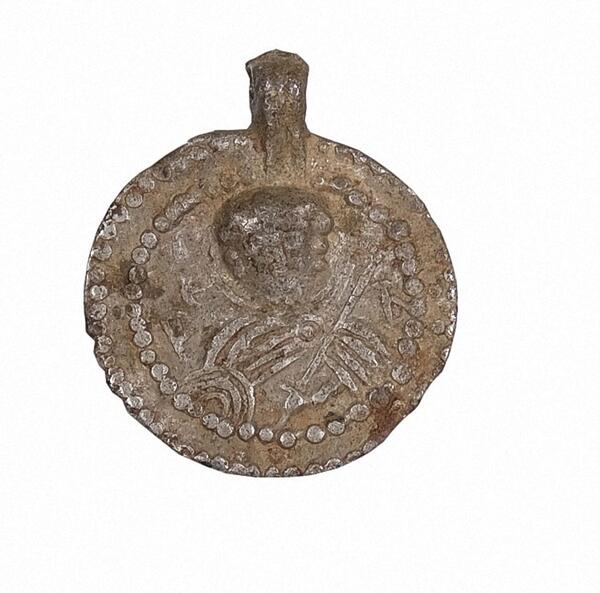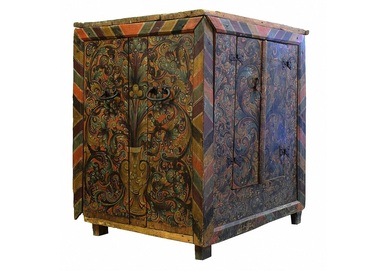In the autumn of 2015, the Kargopol Museum received a rare find from the village of Tikhmanga, located 40 kilometers from Kargopol — a pendant with the sign of the princely family. It was accidentally discovered on the left bank of the Tikhmanga River by locals.
The item looks like a flat circle with an eyelet. An unknown craftsman cast it from a light tin alloy using a double-sided casting mold. On the front side, there is a picture of St. George dressed in a cloak fastened with a round clasp on his chest. A halo is visible around the uncovered curly head. The saint’s left hand holds a spear, and in the right one is a round shield. The figure is flanked by a barely distinguishable inscription in Russian — “George”.
The reverse shows the symbol of the princely family in the form of a trident with a circle on top of the middle prong. Such signs did not designate the whole family or family line but rather signified the rule of some particular prince. They were placed on stamps, seals, coins and other similar items.
The ancient Russian symbols of the princely family all used the image of a bident, and up to Yaropolk Svyatoslavich, who ruled in Kyiv in 972–978, the rulers inherited them directly. But Yaropolk’s brother, Vladimir Svyatoslavich, changed the bident to a trident when his father was still alive. And although the former remained the first choice among most of Vladimir’s descendants, tridents also became popular in the 12th — 13th centuries.
The pendant from the museum’s collection was inspired by silver coins with the inscription in Russian “YAROSLAVL SREBRO” — the oldest Russian coins that were issued under Prince Yaroslav the Wise in the first half of the 11th century. They also had the figure of St. George and the ancestral symbol of Yaroslav. Such coins were minted during his reign of Novgorod in 1010–1019 to pay the Varangian Guard: he first resorted to their services because of a conflict with his father and then once again to fight his brothers during the struggle for the Kyiv throne. He ruled Kyiv in 1016–1018 and 1019–1054. During his reign, the city became the richest one.
Pendants with an eyelet made of tin alloys, copying Yaroslav’s silver coins, were often found on the territory of Northwestern and Northeastern Russia, as well as in Scandinavia. The majority of them were concentrated in Novgorod and on its outskirts. Therefore, it is believed that Novgorod was the center of production.
Such pendants were not just pectorals: most likely, they emphasized the special social status of their owners. The pendant with the ancestral sign of the Rurikovich family from Tikhmanga could belong to an official of the Novgorod princely administration — perhaps to some local fur tax collector.
The item looks like a flat circle with an eyelet. An unknown craftsman cast it from a light tin alloy using a double-sided casting mold. On the front side, there is a picture of St. George dressed in a cloak fastened with a round clasp on his chest. A halo is visible around the uncovered curly head. The saint’s left hand holds a spear, and in the right one is a round shield. The figure is flanked by a barely distinguishable inscription in Russian — “George”.
The reverse shows the symbol of the princely family in the form of a trident with a circle on top of the middle prong. Such signs did not designate the whole family or family line but rather signified the rule of some particular prince. They were placed on stamps, seals, coins and other similar items.
The ancient Russian symbols of the princely family all used the image of a bident, and up to Yaropolk Svyatoslavich, who ruled in Kyiv in 972–978, the rulers inherited them directly. But Yaropolk’s brother, Vladimir Svyatoslavich, changed the bident to a trident when his father was still alive. And although the former remained the first choice among most of Vladimir’s descendants, tridents also became popular in the 12th — 13th centuries.
The pendant from the museum’s collection was inspired by silver coins with the inscription in Russian “YAROSLAVL SREBRO” — the oldest Russian coins that were issued under Prince Yaroslav the Wise in the first half of the 11th century. They also had the figure of St. George and the ancestral symbol of Yaroslav. Such coins were minted during his reign of Novgorod in 1010–1019 to pay the Varangian Guard: he first resorted to their services because of a conflict with his father and then once again to fight his brothers during the struggle for the Kyiv throne. He ruled Kyiv in 1016–1018 and 1019–1054. During his reign, the city became the richest one.
Pendants with an eyelet made of tin alloys, copying Yaroslav’s silver coins, were often found on the territory of Northwestern and Northeastern Russia, as well as in Scandinavia. The majority of them were concentrated in Novgorod and on its outskirts. Therefore, it is believed that Novgorod was the center of production.
Such pendants were not just pectorals: most likely, they emphasized the special social status of their owners. The pendant with the ancestral sign of the Rurikovich family from Tikhmanga could belong to an official of the Novgorod princely administration — perhaps to some local fur tax collector.



